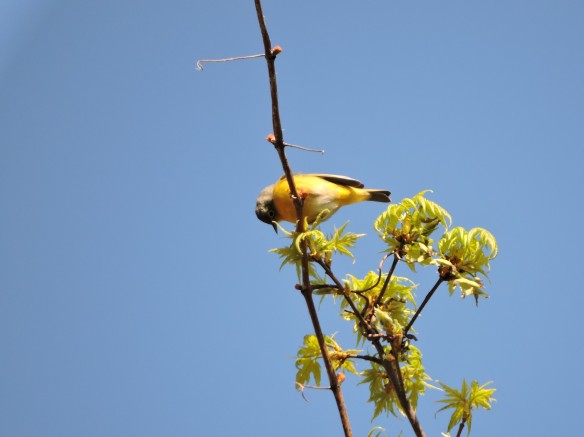Last week I was traveling along the bottom of Indiana for work. I had an overnight stay in Clarksville, which is just across the Ohio River from Louisville, Kentucky. I went out early in the morning to bird at the Falls of the Ohio. This part of the state is interesting in that anything in the water is technically in Kentucky. So I added a new state to my eBird map!

The Falls of the Ohio
The Falls are the only natural impediment on the otherwise totally navigable Ohio River. So a long time ago they were dammed. The only falls now are from water streaming over a controlled spillway.

Ohio Riverbank at The Falls
The best birding was on the Indiana side of the river. With winter high waters bringing in lots of debris, there was ample cover for the birds.

White-eyed Vireo
I was hoping to tally up a list of resident birds and early migrants to start a solid Clark County list. But I was surprised fairly quickly by getting a lifer White-eyed Vireo. This bird has been an annoying nemesis for me, and it was the most common bird remaining for me to see on my Indiana eBird targets list. That distinction now belongs to Northern Bobwhite.

Nashville Warbler
Being almost 200 miles south of home, there were several early migrants around that have not yet made an appearance in Allen County. This Nashville Warbler was one of them, along with several Northern Parulas (parulae?).

Song Sparrow
Song Sparrows, however, are something that can be enjoyed year-round anywhere in the state. This one begged me to photograph it, but it strangely wasn’t singing.

Black Vultures
Black Vultures are common in Indiana, but only when you get into the hills in the southern third of the state. A pair watched me inquisitively as I made my way back to the car.

Lost Binoculars
Even with a lifer, the most interesting thing I saw during the morning ended up being a pair of binoculars about 30 feet up in a huge tree growing in the middle of the river. I figure they were thrown in a fit of anger by a birder who failed to lifer a White-eyed Vireo like I did. Either that or they were found by some kids who decided to see how far they could chuck them. But it’s probably the first one. In any case, I posted photos of my outing to the Birding Indiana Facebook group, and this photo by far got the most likes along with some other theories on how they came to land here.

Eared Grebe
The Falls were not the only birding I did on my trip. The previous day, I drove the entire length of Interstate 69 from northeast to southwest through Indiana. At about the midway point in Hamilton County there had been a long-staying Eared Grebe at a retention pond next to a hospital right off of the highway. I decided to stop since I was driving within half a mile of the location. Initially I feared it had flown as I scanned the large pond and didn’t see anything besides Mallards. But then the bird popped up out of the water perhaps 20 feet from me and proceeded to just float there. This grebe was also a lifer for me, and probably the single best combination of both easiest chase and best view.
I have now seen four species of grebe in Indiana in the course of one month without visiting Lake Michigan. That feat is pretty difficult to accomplish even if you are trying for the grebe quadfecta in this state. The Red-necked Grebe that I found in March ended up being a bigger deal than I originally thought, with folks posting it to the rare bird alert (which I didn’t realize it was eligible for). eBird tells me that people even chased it from as far away as Indianapolis, which is pretty cool. Yay grebes!
